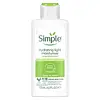What's inside
What's inside
 Key Ingredients
Key Ingredients

 Benefits
Benefits

 Concerns
Concerns

 Ingredients Side-by-side
Ingredients Side-by-side

Water
Skin ConditioningGlycerin
HumectantParaffinum Liquidum
EmollientPolyglyceryl-3 Methylglucose Distearate
EmulsifyingCetyl Palmitate
EmollientDimethicone
EmollientPanthenol
Skin ConditioningTocopheryl Acetate
AntioxidantBorago Officinalis Seed Oil
EmollientPantolactone
HumectantBisabolol
MaskingSodium Lactate
BufferingLactic Acid
BufferingSerine
MaskingUrea
BufferingSorbitol
HumectantAllantoin
Skin ConditioningSodium Chloride
MaskingPotassium Hydroxide
BufferingCarbomer
Emulsion StabilisingAcrylates/C10-30 Alkyl Acrylate Crosspolymer
Emulsion StabilisingCetyl Alcohol
EmollientPentylene Glycol
Skin ConditioningDisodium EDTA
Methylparaben
PreservativePropylparaben
Preservative2-Bromo-2-Nitropropane-1,3-Diol
PreservativeMica
Cosmetic ColorantTitanium Dioxide
Cosmetic ColorantWater, Glycerin, Paraffinum Liquidum, Polyglyceryl-3 Methylglucose Distearate, Cetyl Palmitate, Dimethicone, Panthenol, Tocopheryl Acetate, Borago Officinalis Seed Oil, Pantolactone, Bisabolol, Sodium Lactate, Lactic Acid, Serine, Urea, Sorbitol, Allantoin, Sodium Chloride, Potassium Hydroxide, Carbomer, Acrylates/C10-30 Alkyl Acrylate Crosspolymer, Cetyl Alcohol, Pentylene Glycol, Disodium EDTA, Methylparaben, Propylparaben, 2-Bromo-2-Nitropropane-1,3-Diol, Mica, Titanium Dioxide
Water
Skin ConditioningAloe Barbadensis Leaf Juice
Skin ConditioningDicaprylyl Carbonate
EmollientGlycerin
HumectantPyrus Malus Pulp Extract
Skin ConditioningPropanediol
SolventPanthenol
Skin ConditioningC12-16 Alcohols
EmollientCocos Nucifera Fruit Extract
EmollientCeramide Ns
Skin ConditioningSodium Hyaluronate
HumectantAlgae Extract
EmollientTocopherol
AntioxidantJojoba Esters
EmollientSodium PCA
HumectantHydrogenated Lecithin
EmulsifyingFurcellaria Lumbricalis Extract
Skin ConditioningGelidiella Acerosa Extract
Skin ProtectingDiutan Gum
Trehalose
HumectantGlyceryl Caprylate
EmollientPalmitic Acid
EmollientCetyl Alcohol
EmollientErythritol
HumectantSodium Phytate
Caprylhydroxamic Acid
Octyldodecanol
EmollientHydrolyzed Jojoba Esters
Skin ConditioningHydrolyzed Algae Extract
Skin ConditioningPhytosterols
Skin ConditioningLactobacillus/Clover Flower Ferment Extract
Skin ConditioningHibiscus Esculentus Fruit Extract
Skin ConditioningIsopentyldiol
HumectantSodium Benzoate
MaskingPotassium Sorbate
PreservativeMyristyl Alcohol
EmollientPantolactone
HumectantStearyl Alcohol
EmollientAlcohol Denat.
AntimicrobialSodium Chloride
MaskingTrihydroxystearin
Skin ConditioningCI 77492
Cosmetic ColorantParfum
MaskingWater, Aloe Barbadensis Leaf Juice, Dicaprylyl Carbonate, Glycerin, Pyrus Malus Pulp Extract, Propanediol, Panthenol, C12-16 Alcohols, Cocos Nucifera Fruit Extract, Ceramide Ns, Sodium Hyaluronate, Algae Extract, Tocopherol, Jojoba Esters, Sodium PCA, Hydrogenated Lecithin, Furcellaria Lumbricalis Extract, Gelidiella Acerosa Extract, Diutan Gum, Trehalose, Glyceryl Caprylate, Palmitic Acid, Cetyl Alcohol, Erythritol, Sodium Phytate, Caprylhydroxamic Acid, Octyldodecanol, Hydrolyzed Jojoba Esters, Hydrolyzed Algae Extract, Phytosterols, Lactobacillus/Clover Flower Ferment Extract, Hibiscus Esculentus Fruit Extract, Isopentyldiol, Sodium Benzoate, Potassium Sorbate, Myristyl Alcohol, Pantolactone, Stearyl Alcohol, Alcohol Denat., Sodium Chloride, Trihydroxystearin, CI 77492, Parfum
 Reviews
Reviews

Ingredients Explained
These ingredients are found in both products.
Ingredients higher up in an ingredient list are typically present in a larger amount.
Cetyl Alcohol is a fatty alcohol. Fatty Alcohols are most often used as an emollient or to thicken a product.
Its main roles are:
Though it has "alcohol" in the name, it is not related to denatured alcohol or ethyl alcohol.
The FDA allows products labeled "alcohol-free" to have fatty alcohols.
Learn more about Cetyl AlcoholGlycerin is already naturally found in your skin. It helps moisturize and protect your skin.
A study from 2016 found glycerin to be more effective as a humectant than AHAs and hyaluronic acid.
As a humectant, it helps the skin stay hydrated by pulling moisture to your skin. The low molecular weight of glycerin allows it to pull moisture into the deeper layers of your skin.
Hydrated skin improves your skin barrier; Your skin barrier helps protect against irritants and bacteria.
Glycerin has also been found to have antimicrobial and antiviral properties. Due to these properties, glycerin is often used in wound and burn treatments.
In cosmetics, glycerin is usually derived from plants such as soybean or palm. However, it can also be sourced from animals, such as tallow or animal fat.
This ingredient is organic, colorless, odorless, and non-toxic.
Glycerin is the name for this ingredient in American English. British English uses Glycerol/Glycerine.
Learn more about GlycerinPanthenol is a common ingredient that helps hydrate and soothe the skin. It is found naturally in our skin and hair.
There are two forms of panthenol: D and L.
D-panthenol is also known as dexpanthenol. Most cosmetics use dexpanthenol or a mixture of D and L-panthenol.
Panthenol is famous due to its ability to go deeper into the skin's layers. Using this ingredient has numerous pros (and no cons):
Like hyaluronic acid, panthenol is a humectant. Humectants are able to bind and hold large amounts of water to keep skin hydrated.
This ingredient works well for wound healing. It works by increasing tissue in the wound and helps close open wounds.
Once oxidized, panthenol converts to pantothenic acid. Panthothenic acid is found in all living cells.
This ingredient is also referred to as pro-vitamin B5.
Learn more about PanthenolPantolactone is a synthetically created humectant.
As a humectant, Pantolactone helps draw moisture to the skin. It can help add hydration to your skin.
Chances are, you eat sodium chloride every day. Sodium Chloride is also known as table salt.
This ingredient has many purposes in skincare: thickener, emulsifier, and exfoliator.
You'll most likely find this ingredient in cleansers where it is used to create a gel-like texture. As an emulsifier, it also prevents ingredients from separating.
There is much debate on whether this ingredient is comedogenic. The short answer - comedogenic ratings don't tell the whole story. Learn more about comegodenic ratings here.
The concensus about this ingredient causing acne seems to be divided. Research is needed to understand if this ingredient does cause acne.
Scrubs may use salt as the primary exfoliating ingredient.
Learn more about Sodium ChlorideWater. It's the most common cosmetic ingredient of all. You'll usually see it at the top of ingredient lists, meaning that it makes up the largest part of the product.
So why is it so popular? Water most often acts as a solvent - this means that it helps dissolve other ingredients into the formulation.
You'll also recognize water as that liquid we all need to stay alive. If you see this, drink a glass of water. Stay hydrated!
Learn more about Water